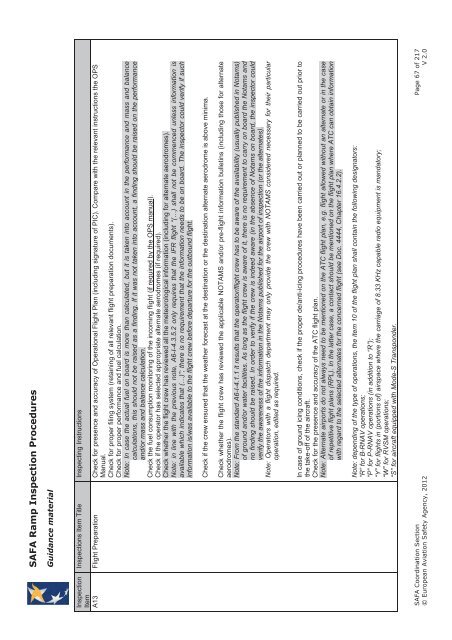SAFA Ramp Inspections - Code7700
SAFA Ramp Inspections - Code7700
SAFA Ramp Inspections - Code7700
Create successful ePaper yourself
Turn your PDF publications into a flip-book with our unique Google optimized e-Paper software.
<strong>SAFA</strong> <strong>Ramp</strong> Inspection ProceduresGuidance materialInspectionItem<strong>Inspections</strong> Item Title Inspecting InstructionsA13 Flight Preparation Check for presence and accuracy of Operational Flight Plan (including signature of PIC). Compare with the relevant instructions the OPSManual.Check for proper filing system (retaining of all relevant flight preparation documents).Check for proper performance and fuel calculation.Note: In case the actual fuel on board is more than calculated, but it is taken into account in the performance and mass and balancecalculations, this should not be raised as a finding. If it was not taken into account, a finding should be raised on the performanceand/or mass and balance calculation.Check the fuel consumption monitoring of the incoming flight (if required by the OPS manual).Check if the operator has selected appropriate alternate aerodromes (if required).Check whether the flight crew has reviewed all the meteorological information (including for alternate aerodromes).Note: in line with the previous note, A6-I-4.3.5.2 only requires that the IFR flight “(…) shall not be commenced unless information isavailable which indicates that (…)”; there is no requirement that the information needs to be on board. The inspector could verify if suchinformation is/was available to the flight crew before departure for the outbound flight.Check if the crew ensured that the weather forecast at the destination or the destination alternate aerodrome is above minima.Check whether the flight crew has reviewed the applicable NOTAMS and/or pre-flight information bulletins (including those for alternateaerodromes).Note: From the standard A6-I-4.1.1 it results that the operator/flight crew has to be aware of the availability (usually published in Notams)of ground and/or water facilities. As long as the flight crew is aware of it, there is no requirement to carry on board the Notams andno finding should be raised. In order to verify if the crew is indeed aware (in the absence of Notams on board, the inspector couldverify the awareness of the information in the Notams published for the airport of inspection (or the alternates).Note: Operators with a flight dispatch department may only provide the crew with NOTAMS considered necessary for their particularoperation, edited as required.In case of ground icing conditions, check if the proper de/anti-icing procedures have been carried out or planned to be carried out prior tothe take-off of the aircraft.Check for the presence and accuracy of the ATC flight plan.Note: Alternate airports do not always need to be mentioned on the ATC flight plan, e.g. flight allowed without an alternate or in the caseof repetitive flight plans (RPL). In the latter case, a contact should be mentioned on the flight plan where ATC can obtain informationwith regard to the selected alternates for the concerned flight (see Doc. 4444, Chapter 16.4.2.2).Note: depending of the type of operations, the item 10 of the flight plan shall contain the following designators:“R” for B-RNAV operations;“P” for P-RNAV operations (in addition to “R”);“Y” for flights in (portions of) airspace where the carriage of 8.33 KHz capable radio equipment is mandatory;“W” for RVSM operations;“S” for aircraft equipped with Mode-S Transponder.<strong>SAFA</strong> Coordination Section Page 67 of 217© European Aviation Safety Agency, 2012 V 2.0
















